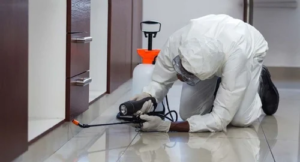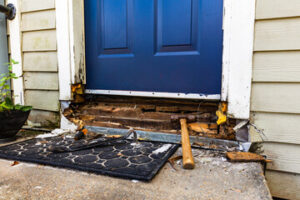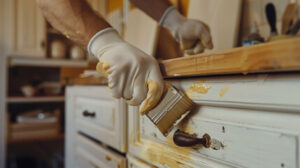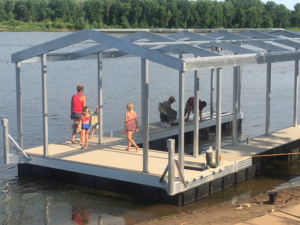Mold is an invasive fungus that thrives on moisture and organic matter. It can be difficult to eradicate from some materials, such as antique rugs.
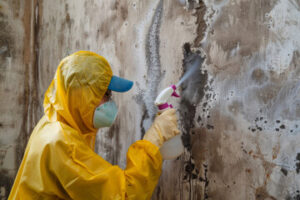
There are many commercial and household cleaning products available for removing mold, including the common household items of hydrogen peroxide, vinegar, and dish soap. These products may also include bleach and other fungicides, which can kill mold spores and disinfect surfaces. Contact Mold Removal Salt Lake City for professional help.
A little soap and water may be all you need to get rid of a light mold problem. Mix a bit of dishwashing liquid with warm water and rub it into the affected area with a damp sponge. This will usually eliminate the mold spots. Rinse well with warm, clean water and wipe dry with a towel. Repeat as needed. If the mold spots continue to reappear, you may need to follow up with more powerful cleaning methods.
Bleach can be used to remove small patches of mildew or mold on surfaces such as tile, wood and vinyl floors. However, bleach can irritate lungs and skin and cause stains if it is not used properly. Bleach also produces harsh fumes and can stain fabric, carpet and some types of paint if it comes into contact with them. Before you use bleach, make sure you are working in a well-ventilated area and that you have protective gloves, goggles and a mask.
Another effective mold removal method is hydrogen peroxide. This antibacterial and antifungal agent works on most surfaces and doesn’t produce the harsh fumes that bleach does. This is a good choice for fabrics and wood, although it should not be used on linoleum, glazed tiles or painted surfaces. Vinegar is also a safe, effective mold cleaner that is effective on most surfaces. It can be diluted with water or added to other natural cleaners such as baking soda, lemon juice or tea tree oil to decrease its strong odor.
If you have a large infestation of black mold or if the problem extends to porous materials, such as drywall and paper, it is recommended that you call an expert in mold removal. This type of professional will test the mold and create a plan to clean and prevent it from coming back.
A few other simple ways to fight a mildew or mold problem are to sprinkle the spot with baking soda and let it sit overnight, vacuum up the baking soda in the morning, run fans and dehumidifiers in the area and wash any items that have absorbed the smell in the laundry machine.
Hydrogen Peroxide
Hydrogen peroxide is a common household item with powerful antifungal and disinfecting properties. Its oxidizing action chemically disrupts the cell walls of bacteria and mold spores, killing them on contact. This is similar to how bleach works, but peroxide is non-toxic and produces no harmful fumes. Furthermore, unlike bleach, hydrogen peroxide can penetrate porous materials like wood and drywall to kill the mold at the source.
Basements are prime places for mold growth due to poor ventilation, water leaks from plumbing and storm damage, and condensation. Bleach is often used to clean these areas, but prolonged exposure to bleach fumes can irritate the eyes, lungs, and skin, especially for people with asthma or other respiratory conditions.
A better alternative to bleach is standard 3% hydrogen peroxide, which can be applied directly to the affected area with a spray bottle. Just be sure to wear a face mask when applying it. Let it sit for about an hour before scrubbing to ensure proper penetration and effectiveness. Hydrogen peroxide is safe for the environment and will not damage most surfaces if the area is well-ventilated.
It’s important to note that while hydrogen peroxide is effective in removing visible mold stains, it will not kill the mycotoxins found within some varieties of mold. This is a concern for homeowners with serious or recurring mold issues in the basement. The underlying cause of the problem must be addressed to prevent future outbreaks.
Tea tree oil is another natural, effective cleaning agent that can be used to remove mold stains. The terpinene-4-ol found in tea tree oil has been shown to inhibit fungi growth and is a powerful antimicrobial. This natural substance is easy to find and can be purchased in a variety of forms, including distilled water, ointments, and cleaners.
Vinegar is another natural way to remove mold stains and kill the mold at the source. Household vinegar typically contains between 5 and 8 percent acetic acid, which can kill some types of mold by disrupting their pH balance. This is a simple solution to try. Just apply the vinegar directly to the affected area and let it set for about an hour before scrubbing.
Vinegar
Vinegar is a natural cleaner and boasts eco-friendly properties. This makes it a great alternative to chemical cleaners and provides an effective way of eliminating mold. Its acidic nature also makes it a potent fungicide, effectively killing and inhibiting future growth. If used properly, it can also be a very effective method of removing mold from non-porous surfaces.
To use vinegar as a mold removal tool, start by preparing the area and wearing all necessary safety equipment. This includes a mask, goggles, and gloves to prevent direct exposure to the mold spores. It is also recommended to open a window in the room that you are working in to allow for adequate ventilation.
Next, pour a solution of equal parts water and white vinegar into an empty spray bottle and apply the solution directly onto the moldy area. For non-porous surfaces, this can be done using a sponge or cloth soaked in the mixture. Allow the solution to sit on the moldy surface for about an hour.
Once the time has passed, remove the solution and scrub the affected area with a brush or rag. This should be done until the mold is removed and the area is completely dry. The rubbing and scrubbing will also help to remove any other dirt or debris on the surface. Once finished, rinse the area with clean water and dry it thoroughly to prevent future mold growth.
While vinegar is effective against a wide range of mold species, it is important to remember that if the source of moisture is not addressed, the mold will likely return. As such, it is often more effective to address the source of moisture and then clean the area using other methods. For instance, if you are trying to eliminate black mold, vinegar may not be as effective as bleach or a commercial black mold killer. This is because it has difficulty penetrating into porous materials like wood or drywall, allowing it to only remove the surface layer of the mold. If you are struggling to kill the mold with vinegar, consider using a professional mold remediation company to assist you.
Scrub Brush
A scrub brush can help remove stubborn mold from hard-to-reach places, such as behind toilets and in shower nooks. The scrubbing action of the brush helps remove dirt and grime, which also helps to kill mold spores. Once you’re done scrubbing, make sure to rinse and dry the walls thoroughly with fans or a dehumidifier. If you have a persistent problem with mold in your bathroom, you may want to invest in a commercial mold cleaner. This type of product is typically formulated with stronger chemicals, such as hydrochloric acid (HCL), which can be effective in killing some types of mold.
It’s important to wear gloves and a mask when cleaning mold, as mold spores can cause respiratory issues, allergies, and worsen conditions like asthma. You should also be sure to open windows and turn on the bathroom fan when cleaning. This will reduce the amount of moisture in the air and prevent mold from spreading to other parts of your home.
Vinegar is a powerful mold killer that can be used to clean surfaces in the bathroom. Unlike bleach, which cleans and then kills mold, vinegar is a pure solution that simply kills mold on contact. When using vinegar, make sure to dilute it with water so that its potent acidic properties don’t damage surfaces in your bathroom.
To use vinegar to kill mold, spray affected surface areas and let sit for up to an hour. Be sure to leave the windows open during this time and use a clean towel to wipe surfaces when they are dry. Vinegar can kill some types of mold, including black, penicillium, and chrysogenum, but it is not effective against Aspergillus fumigatus.
If you have a persistent problem with mold, it’s worth investing in a good quality scrub brush and a bucket. The sturdy bucket makes it easy to mix and carry your cleaning solution, while the scrub brush allows you to get into corners and cracks where mold often grows.


